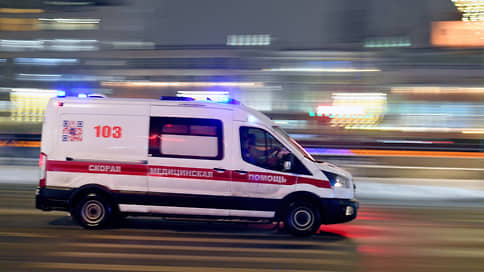There’s no need to rush into the ambulance
[ad_1]

A number of Telegram channels have published internal correspondence between doctors of the Moscow emergency service, in which they discuss the increased percentage of hospitalizations and the need, in this regard, to coordinate with the management the sending of patients to hospitals. The situation was confirmed to Kommersant by the head of the Feldsher.ru trade union, Dmitry Belyakov. Another Kommersant source in medical circles assured that such a coordination mechanism was introduced at the beginning of the coronavirus pandemic in order to exclude medical evacuation to the hospital of “mild” patients for whom outpatient treatment was sufficient.
In a number of Telegram channels, in particular in “Genuine News 103”, screenshots of the WhatsApp chat “Senior Doctor 61PS” (post No. 61 of the A.S. Puchkov City Emergency Medical Care Station in Moscow) appeared. In correspondence with colleagues, the manager reminds that ambulance teams, before making a request for medical evacuation of a patient who has come to receive a call, must consult with a senior doctor or the manager: “If you haven’t called back, please kindly explain the reason in writing. Half of those whom you transport unreasonably are not kept in hospitals, or they themselves refuse hospitalization.” She reminds that medical evacuation should be carried out “only when it is really necessary and/or prescribed in the algorithms.”
The Telegram channel “Caution, Moscow,” citing correspondence and anonymous doctors, concluded that such requirements are associated with a growing percentage of hospitalizations. Doctors, according to the Telegram channel, were given a standard: the percentage of hospitalizations should not exceed 30% of the number of calls made by the substation.
Dmitry Belyakov told Kommersant about a verbal order not only in Kommunarka, but also in other hospitals, where the “percentage of hospitalizations” is indicated: if it is exceeded, ambulance crews “face explanatory and other troubles.” According to Mr. Belyakov, this is an order from the management of the Moscow ambulance service, and ambulance doctors and paramedics, since they are mostly from out of town, “in mortgages and loans,” are afraid of losing their jobs and carry it out “with terrible force.”
However, another Kommersant source familiar with the situation insists that the media space is “exaggerating things.”
The mechanism, when teams agree with management on the need for hospitalization, he notes, was introduced at the beginning of the coronavirus pandemic. This measure is aimed at relieving the healthcare system by eliminating the delivery of “mild” patients to hospitals for whom outpatient treatment is sufficient. “There are a lot of employees – 10 thousand people, and everyone, let’s be honest, has a different level of education. In addition, there are young paramedics who have just completed their studies. Therefore, a decision was made: if employees want to take them to the hospital, they report the patient’s condition to the senior doctor or manager and jointly make a decision. This does not mean that complex patients will be treated at home. For example, I have never been refused when I spoke about the need for hospitalization. On the contrary, this is such a protection against fools that some employee does not decide to take ARVI to the hospital on the third day for no apparent reason and take the place of a serious patient there,” the interlocutor explained. He also recalled the queues outside Moscow infectious diseases hospitals, which the media recently wrote about. In his assessment, the situation has now improved, partly because paramedics and their management jointly decide on the need to take the patient to the hospital. In general, there have been more calls lately, Kommersant’s interlocutor said: “We always have a full house in winter – now the influenza virus, mycoplasma pneumonia. But not every case is adequate. They can call for a temperature of 37 on the second day, sometimes just frightened Muscovites call an ambulance.”
Kommersant asked the Moscow Health Department to comment on the situation, but did not receive a response at the time of publication. Previously, the Department of Health stated that there is no significant increase in hospitalizations for ARVI and coronavirus in Moscow; in most cases, the disease occurs in mild to moderate severity, and treatment is carried out on an outpatient basis.
In general, in Russia, according to Rospotrebnadzor, there is an increase in the incidence of ARVI and influenza; over the week the figure increased by 6.5%. In 41 regions, incidence rates exceed the Russian average. “The structure is dominated by respiratory viruses of non-influenza etiology – 68.3%. The share of influenza viruses continues to increase and amounts to 31.7%,” the department clarified.
Meanwhile, the World Health Organization (WHO) has drawn attention to the rapid spread of the new JN.1 variant of the SARS-CoV-2 coronavirus. She classified it as a “variant of interest” (VOI), warning that it could cause a rise in cases as winter approaches in the Northern Hemisphere. Data available to WHO indicate that the additional global public health risk posed by JN.1 is currently assessed as low. “Despite this, with the onset of winter in the Northern Hemisphere, JN.1 may increase the burden of respiratory infections in many countries,” the WHO stated.
[ad_2]
Source link








